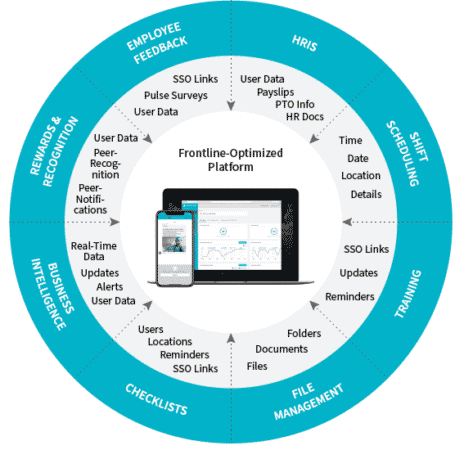
Having a digital workplace is more than downloading apps, automating HR functions, and adopting communication tools. There should also be a well-thought-out digital strategy in place that integrates those tools in order to maximize your operational potential.
Want to learn how to get employee buy-in for your digital transformation strategy? Download our Frontline Worker Technology Report.
Like any business strategy, the ultimate goal of digital initiatives is to drive better business returns. A digital workplace will accomplish this by improving the performance of individual business components, like productivity, efficiency, and employee engagement, and collectively boost your bottom line.
What Is a Digital Transformation Strategy?
A digital transformation strategy is a company’s plan of action to apply technology to handle internal processes and communication in order to improve business performance and outcomes.
A digital strategy definition goes deeper than apps and software. A digital transformation should create a cultural shift that inspires a workforce to embrace agility and respond to change with ease.
A digital transformation often begins with the question, “How can we do this better, faster, and more efficiently, for less?”

A digital strategy should incorporate tools for both people and processes—it should include an enterprise-wide communication platform as well as software to automate operations. This can mean different things for different businesses. In industries like retail, a digital strategy might encompass anything from a POS (Point Of Sale) system to digital marketing to inventory management.
In manufacturing, it might mean A.I. on the production lines and building a digitally connected workforce. A digital strategy loops all of these different internal systems together in a secure, often cloud-based network for a lean, efficient organization.
Why You Need a Digital Strategy
You might be wondering, “My company’s fine. Why do we need a digital strategy?” The short answer? You’ll fall behind all of your competitors. The speed of business operations and transactions is increasing. Technology helps companies keep up and even set the pace.

While more companies were already beginning their digital journey, COVID-19 accelerated the rise of the digital workplace.
By 2023, companies are expected to spend $2.3 trillion on workplace technology. Transitioning to a digital environment can help a company stay relevant, competitive, and viable.
While your business might be performing well, technology can help shed excess costs and waste that you don’t even realize are weighing things down. It will also create a foundation for lean operational management that will help you save money in all areas of your business.
Set Your Digital Strategy With a Transformation Roadmap
While you should begin a digital transformation to stay competitive, you need to develop a unique path to transformation based on your company’s goals. To create your roadmap, start with where you are now and draw a line to where you want to be. Now, add digital milestones that will help you achieve this goal.
As you design your digital workplace strategy, you should do the following:
- Get a benchmark of how your current processes are operating and the associated numbers, like daily product output or sales
- Know exactly what you want to achieve
- Understand what your employees need to be successful in their work
- Determine the technology and tools you need to reach your customers
- Establish the KPIs that will help you measure the success of your digital strategy
You don’t need to do a complete digital overhaul all at once. You can take a measured approach to building a digital workplace.
5 Advantages of a Digital Strategy
As you begin incorporating technology into your operation, you’ll see benefits across all areas.
- Digitally connected workers are able to be more productive and innovative
- Greater agility will allow your company to pivot to new operational strategies in a crisis
- A greater amount of data at your fingertips will enable you to make strategic decisions
- You’ll attract and retain more talent with technology. Today’s worker is 450% more likely to jump ship for a company with better tech.
- A digital workplace breaks down silos so information can move freely within the organization to maximize efficiency.
Once you know why you need to chart this new course and create your roadmap, you can begin your digital transformation.
Three Digital Strategy Components You Need to Know
Once you’re ready to set the plan in motion, consider these three essential building blocks for a successful digital transformation:
1. The Right Tools
Determine what digital features your workforce needs. You need communication tools that complement how they work, make their jobs easier, and maximize their productivity. For businesses with a large frontline workforce, like a manufacturing company, hotel, or healthcare facility, look for a team app designed for mobility. It’s an employee portal to the digital workplace accessed through smart devices.
A patchwork of apps and programs stitched loosely together creates data silos and interrupted, inefficient workflows that further fractures a dispersed workforce. An operational communication platform with custom integrations allows a company’s apps and legacy systems to live in a unified ecosystem.

2. Employee Buy-In and Inclusion
By the end of 2019, companies spent a whopping $2 trillion on digital transformation. For their strategy to be successful, organizations need buy-in at all levels, from frontline workers to middle managers, to CEOs. Employees will support your digital movement when you’ve established a company culture based on adaptability and innovation.
Without employee adoption of the digital workplace, there will be gaps in communication, operational inefficiencies, and stagnant growth. When your workforce aligns with your company culture, they’ll buy into your vision. Access to the same data in real time will create a unified team that works collaboratively, communicates effectively, and moves together in the same direction.
Some ideas to help build employee buy-in include:
- Have engagement-building content, like town halls and employee recognition streams.

- Invest a chunk of your technology budget into your employees. A mobile app can help to flatten the corporate hierarchy, include frontline workers in communication, and gives them an opportunity to provide valuable feedback, insight, and ideas.
- Offer upskilling over your mobile workplace app so employees have opportunities for professional growth. Train them to work with the automated systems you’ve put in place then promote from within.
If your team needs an extra push to adopt your digital workplace vision, try these tips to get them on board.
3. Digital Leaders to Design, Roll Out, and Manage Your Plan
Identify and promote a visionary to helm your digital workforce transformation. From design to implementation to the day-to-day management of your communication tools and team app, your digital leader will handle the logistics and be the point person for your company. Of equal importance, this individual should be a champion of both your brand and your chosen communication tool to drive employee engagement with the new technology.
This digital leader might be someone you hire from the outside or a rising star you’ve cultivated from within your workforce.
Here are the qualities a digital leader should possess:
- An influencer and team player who colleagues respect, and who drives employee engagement.
- Ability to make data-driven decisions using the analytics of the team app to drive success.
- Strategic risk-taker skilled in the art of disruption and navigating a team through it.
Track Future Digital Developments
If there’s one constant when it comes to technology, it’s that it is always changing. Digital transformation isn’t always a stop-start process. You should have a core value of kaizen—a business management strategy based on continuous improvement.
Familiarize yourself, and your company, with digital trends in your industry. Track emerging technology so you can continue to adapt and evolve, always ensuring you’re working as efficiently as possible.
3 Best Practices for Managing Your Digital Initiatives
1. Measuring Digital Strategy ROI
Track KPIs to measure the success of your strategy. Employee engagement is one of the most important indicators of the health of your company. Companies lose an accumulated $7 trillion in productivity due to low employee engagement. When your workforce is thriving and happy in their careers, it will show in your numbers. Most often, low engagement comes down to a lack of feeling valued, lack of recognition, and limited connection at work. Giving them tools to be part of the team reinvigorates employees.
Track engagement and adoption of your digital workplace through your app’s analytics dashboard. If those numbers are climbing, you’ll see other positive results, like higher output and production speed, more innovation, and — your ultimate goal— great returns.
2. Focus on Your Frontline Workers
A digital strategy will best serve your company if it is inclusive of every worker. Select a mobile-first tool that levels the playing field and gives every employee equal opportunity to communicate, collaborate, and share ideas.
Frontline workers are the ones most in touch with your product and your customers. Giving them the tools and opportunity to share their insights will benefit the entire organization. And simply asking for their participation and recognizing the value they bring to the team has a big impact on boosting engagement.
3. Embrace Agility
Across many industries, some businesses have been slower to go through the motions of a digital transformation. But if there’s one thing companies have learned during COVID-19, it is that agility can help a company survive a crisis.
Companies with a digital infrastructure in place entered the pandemic prepared to pivot strategies. Food establishments could switch from dine-in customers to creating a delivery service seemingly overnight in order to stay in business. Manufacturers could restructure their supply chains to limit disruptions and meet quotas and deadlines. Learning to embrace the agility that a digital strategy creates for your company and workforce is key to maximizing its potential.
When a digital workplace is implemented as an intentional business solution it delivers results, like a high-performing workforce, that makes your company more competitive. It’s never too late (or too soon) to begin implementing digital initiatives throughout your company.

About the author
Beekeeper
We make frontline lives easier, work safer, and teams more connected so businesses can reach new heights. At Beekeeper, we’re dedicated to making frontline lives easier by connecting workers with the tools, support, and information they need to feel valued, do their best work, and drive the business forward.







